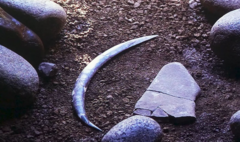The world’s oldest boomerang, initially discovered in Poland back in 1985, has been re-dated to around 40,000 years old, offering an intriguing glimpse into ancient human innovation. This extraordinary tool, shaped from a mammoth's tusk, was unearthed in the Oblazowa Cave, and its latest dating places it among the oldest known tools of its kind.
Researchers have revealed that the boomerang's design would have enabled it to fly efficiently when thrown, although it was not intended to return to the thrower. Experts suggest its primary purpose was likely for hunting, but it may have also held cultural or ritual significance, hinting at the spiritual life of early humans.
Dr. Sahra Talamo of the University of Bologna remarked on the boomerang's exquisite craftsmanship, illuminating the advanced knowledge possessed by Homo sapiens 42,000 years ago. The tool is exceptionally well preserved, even displaying score marks that indicate it had been intricately polished and fashioned for a right-handed user.
While boomerangs are mostly associated with Aboriginal cultures in Australia, this finding broadens our understanding of their historical use across different regions. The oldest known Australian boomerang dates back approximately 10,500 years, while previous finds in Europe include a wooden example from Jutland, and fragments of a 2,000-year-old oak boomerang in the Netherlands.
The groundbreaking research, which included a team of scientists from multiple countries, is documented in the journal PLOS One, adding to the rich tapestry of human history and our connection to the environment and resources in times long past.




















